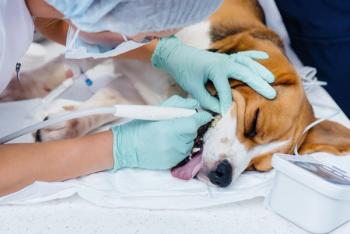
Common diseases of meat goats: Herd diseases (Proceedings)
Information on caseous lymphadenopathy, caprine arthritis encephalitis virus, Johne's disease, and mycoplasmosis in goats.
Caseous Lymphadenopathy
Caseous lymphadenopathy or "CL" is caused by Corynebacterium pseudotuberculosis. This is a very hardy organism that survives for years in the environment. Draining abscesses contaminate the soil, facilities and equipment. The organism gains entry into other animals through cuts and abrasions, the mouth, or lungs.
The clinical signs of this disease are external abscesses at mandibular, parotid, prescapular and prefemoral lymph nodes. Abscesses also occur on the udder. Any swelling/abscess on a small ruminant should be considered CL until proven otherwise. Although less common, abscesses can also occur internally and cause chronic weight loss.
Diagnosis is by culture of the organism from external abscesses. The internal form is a diagnostic challenge. The synergistic hemolysis inhibition test (SHI) detects antibodies to the organism in serum. Cross reaction with other organisms is common, so titers are hard to interpret. Titers of greater than 1:256 indicate internal abscesses. This test does not differentiate infected from vaccinated animals.
Once an animal is infected it is infected for life and can shed organisms in body fluids and abscesses. Therefore, culling infected animals is recommended. External abscesses can be lanced and drained, but frequently recur. Animals with open abscesses should be isolated, since they can spread it to other animals and contaminate the environment. Antibiotics are not effective in curing this disease.
Quarantine, culling and sanitation are important preventive measures. If a majority of animals on a farm are infected, depopulation may be indicated. Care should be taken not to reintroduce the disease. This can be a problem due to the long incubation period (2-3 weeks) and no good prepurchase test. Vaccines are available which may reduce the number and severity of abscesses, but will not eliminate the disease from a herd.
Caprine Arthritis Encephalitis Virus (CAE)
CAE is a lentiviral infection of goats. It is most prevalent in dairy goats but occurs in all goat breeds. Transmission of this disease is mainly through colostrum and milk, but any secretion that contains white blood cells can transmit this virus. Vertical transmission can also occur. An initial acute viremia (clinically inapparent) leads to antibody production. Virus numbers in the body then decrease, but the virus is not totally eliminated, remaining latent. There are some breed differences in susceptibility to the infection. There are also different strains of the virus that differ in virulence. Not all infected goats develop clinical disease. Development of clinical disease determined by virus strain, initial viral load, age and breed of animal, route of exposure, secondary infections, management conditions.
Leukoencephalomyelitis occurs in 1-6 month old kids. Clinical signs start with rear leg paresis and progresses to paralysis. This is the least common form of the disease. More commonly, arthritis develops. It is a chronic, hyperplastic polysynovitis-arthritis most commonly in carpal joints. The mammary gland, lung and CNS may also show signs of disease. Decreased milk production can occur in clinically normal but infected does. Udder lesions that are firm with no abnormal secretions can occur ("hardbag").
Tests for both antibodies and the virus are available. Kids can remain positive to antibody tests for up to six months from colostral antibody absorption.
Preventive methods are:
1. Remove and wash kids at immediately after birth.
2. Heat treatment of goat colostrum (56°C for 1 hour) or use of bovine colostrum and then heat treated milk or milk replacer fed.
3.Serologic surveillance.
4.Segregate or cull positives.
5.Milk seronegative does before seropositive.
6. Avoid venereal or iatrogenic transmission.
Johne's Disease
Johne's disease can occur in goats and has similar pathophysiology as the disease in cattle. Unlike cattle, diarrhea is not common. Severe progressive weight loss is the most common clinical sign. Diagnostic testing is similar to cattle. However, some ELISA tests are better in goats than others. Very detailed information on Johne's disease in goats can be found at the University of Wisconsin's John's Information Center (
Mycoplasmosis
Many species of mycoplasma infect goats and cause a variety of clinical diseases including pink eye, arthritis, pneumonia, mastitis and abortion. Mycoplasma mycoides subspecies mycoides large colony type causes the most severe clinical disease and can remain in a herd through carrier animals. Ear swabs or milk/colostrum can be cultured to try to identify carrier animals. Carrier animals should be culled.
Newsletter
From exam room tips to practice management insights, get trusted veterinary news delivered straight to your inbox—subscribe to dvm360.




